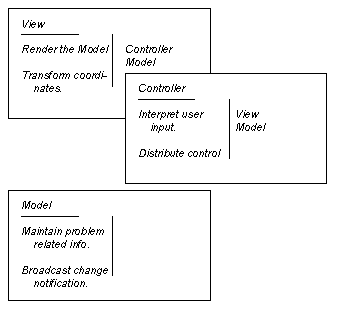CRC Cards
Source: comp.objectDate: 25-Mar-98
[...]
The idea is to assign a class per index card. You write the name of the class on top. On the left side of the card you write the responsibilities that class has. On the right side of the card, you write the names of the other cards/classes that card/class collaborates with. [Hence CRC - Class, Responsibilities, Collaborators -YS]
The information for the cards comes from role playing scenarios. People on the team take on the role of one or more cards as they all talk/walk (literally) through a scenario.
This is useful for a few things:
- Giving people a "feel" for the design.
- Allowing people to propose and test changes to the design rapidly (all you have to do is make new cards)
- Focus on responsibilities as opposed to "N:M attribute" design as promoted by OMT, Booch, etc.
![]() Example - the Model-View-Controller pattern using CRC cards:
Example - the Model-View-Controller pattern using CRC cards:

Kent Beck and Ward Cunningham,
A Laboratory For Teaching Object-Oriented Thinking
(The original article presenting this technique)
Alistair Cockburn, Using CRC Cards
David M. Rubin, Introduction to CRC Cards
Rebecca Wirfs-Brock, Brian Wilkerson and Lauren Wiener,
Designing Object-Oriented Software![]()